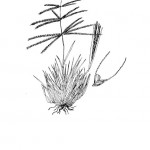Tumble Windmillgrass
Chloris verticillata
Poaceae
Description
This bunchgrass grows in small tufts and has erect or prostrate, flat stems that are usually branched and crowded at the base with leaves. It is rather short, up to 18 inches or 45 cm, with short stolons that can form a mat of turf. Its presence may be a sign of overgrazing. Leaf blades are up to 15 cm by 3 mm, light green, rough, and usually folded. The basal leaves are long and the upper leaves short. The purplish seed head has ten to 16 seed branches that are 5 to 15 cm long arising from nodes regularly spaced along the axis. The branches comprise of one to five well-separated (>5 mm apart) whorls. The tawny, wide-spaced spikelets alternate along these branches and have short awns. Flowering occurs from May to September, and the seeds produced do not appear inflated as they do in C. cucullata. Tumble Windmillgrass is a perennial, warm-season, native grass. Poor grazing for livestock and wildlife, but all livestock graze it in spring and early summer.Habitat
This species is adapted to grow on any soil type. It occurs in heavy, sandy, or gravelly soils of disturbed areas, roadsides, lawns, and parks. It is not common on native rangelands.Images
Plant Characteristics
Duration: Perennial
Stem Texture: Hairless/Smooth
Growth Habit: Bunch grass, Grasses
Season: Warm
Distribution
 : 01 - Pineywoods, 02 - Gulf Prairies and Marshes, 03 - Post Oak Savannah, 04 - Blackland Prairies, 05 - Cross Timbers and Prairies, 06 - South Texas Plains, 07 - Edwards Plateau, 08 - Rolling Plains, 09 - High Plains, 10 - Trans-Pecos
: 01 - Pineywoods, 02 - Gulf Prairies and Marshes, 03 - Post Oak Savannah, 04 - Blackland Prairies, 05 - Cross Timbers and Prairies, 06 - South Texas Plains, 07 - Edwards Plateau, 08 - Rolling Plains, 09 - High Plains, 10 - Trans-Pecos
Distributions
Distribution refers to the ecological region in Texas that a plant has been found. You can also view a clickable map.
Book: Know Your Grasses (B-182)
Collection: Grasses


